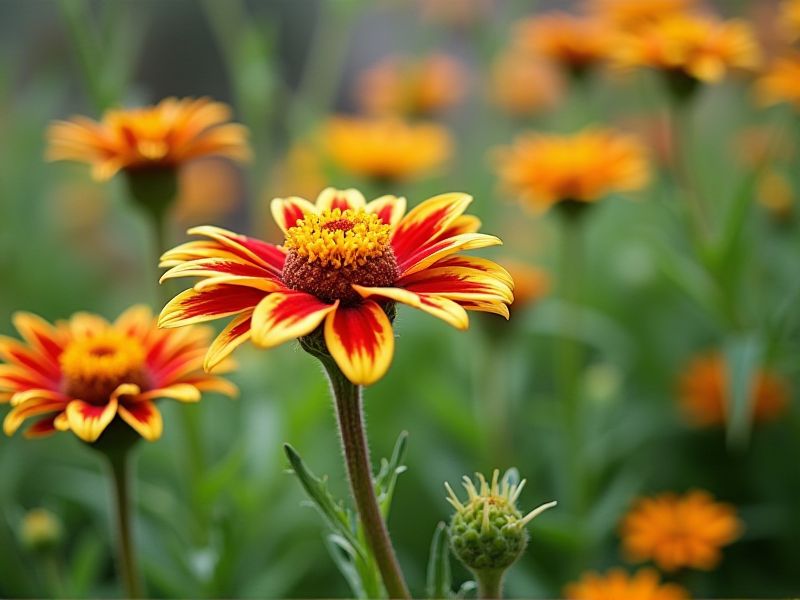
Drought-tolerant plants, such as succulents and native perennials, thrive in low-water conditions, making them ideal for arid climates and xeriscaping. Species like Agave, Lavender, and Sedum showcase remarkable resilience by storing water in their leaves or stems, allowing them to survive extended dry periods. When selecting these plants for your garden, consider factors such as soil type, sunlight exposure, and local climate to optimize growth. Incorporating these resilient varieties can significantly reduce your landscape's water consumption while enhancing its aesthetic appeal. Furthermore, they often attract beneficial pollinators, contributing to local biodiversity.
List of some Drought-tolerant plants that need little water
- Lavender (Lavandula)
- Rosemary (Rosmarinus officinalis)
- Cactus (Cactaceae)
- Agave (Agave americana)
- Bougainvillea (Bougainvillea glabra)
- Oleander (Nerium oleander)
- Sedum (Sedum spp.)
- Yucca (Yucca filamentosa)
- Portulaca (Portulaca grandiflora)
- Lantana (Lantana camara)
Important things about Drought-tolerant plants that need little water
Definition Of Drought-Tolerant Plants
Drought-tolerant plants are specifically adapted to thrive in arid conditions with minimal water requirements, making them ideal for water-wise gardens and landscapes. These plants have developed unique features such as deep root systems, thick leaves, and waxy coatings that help retain moisture and reduce evaporation. Popular examples include succulents like agave and aloe, as well as native grasses and shrubs such as lavender and sage. By incorporating drought-tolerant species into your garden, you can conserve water while still achieving a vibrant and sustainable outdoor space.
Water Conservation Characteristics
Drought-tolerant plants, such as succulents, native grasses, and specific flower varieties, are essential for sustainable landscaping in arid climates. These resilient plants have adapted to thrive with minimal water, featuring deep root systems, thick leaves, and waxy coatings that reduce moisture loss. Incorporating them into your garden not only conserves water but also promotes biodiversity by attracting pollinators and wildlife. Examples include lavender, agave, and sedums, which add aesthetic value while minimizing your ecological footprint.
Soil Adaptability
Drought-tolerant plants are specially adapted to thrive in arid environments, exhibiting features such as deep root systems, waxy leaves, and minimal water loss. Species like succulents, lavender, and native grasses can flourish in poor soil conditions, enhancing landscape resilience while minimizing water requirements. These plants not only conserve moisture but also improve soil structure and biodiversity, making them excellent choices for sustainable gardening. Choosing drought-tolerant varieties for your garden can significantly reduce your water consumption and maintenance efforts, contributing to eco-friendly practices.
Native Species Benefits
Drought-tolerant plants, such as succulents and native xerophytes, are essential for sustainable landscaping and conservation efforts in arid regions. These species are adapted to survive with minimal water, making them an ideal choice for homeowners looking to reduce irrigation costs and environmental impact. By incorporating native plants like agave, yucca, and lavender, you also support local ecosystems, providing habitats for pollinators and other wildlife. Choosing drought-resistant plants not only enhances your garden's resilience to climate change but also promotes biodiversity in your area.
Low Maintenance Requirements
Drought-tolerant plants, such as succulents, lavender, and native grasses, thrive in arid conditions while requiring minimal water. These resilient species adapt their growth patterns and features, like waxy leaves or deep root systems, to conserve moisture and withstand prolonged dry spells. Incorporating these plants into your landscape not only reduces water consumption but also promotes biodiversity by supporting local ecosystems. Choosing drought-resistant varieties can lead to a sustainable garden that blooms beautifully with little upkeep.
Seasonal Growth Patterns
Drought-tolerant plants, such as succulents, cacti, and native perennial species, thrive in arid conditions with minimal water requirements, showcasing unique adaptations for survival. During the growing season, these plants often exhibit vibrant blooms and lush foliage, effectively utilizing water during brief rainfalls to store moisture in specialized tissues. Your garden can benefit from integrating these resilient species, as they not only conserve water but also attract beneficial pollinators while requiring less maintenance than traditional plants. Understanding seasonal growth patterns of drought-tolerant plants allows you to plan your landscape effectively, ensuring vibrant displays even in dry conditions.
Types Of Drought-Tolerant Plants
Drought-tolerant plants such as succulents, cacti, and native grasses are exceptional choices for water-wise gardening, thriving in arid conditions with minimal moisture. Agave, with its stunning rosettes, requires infrequent watering while adding architectural interest to your landscape. Ornamental grasses like Blue Fescue are not only drought-resistant but also provide texture and movement to gardens without substantial water needs. Incorporating these resilient species into your outdoor space can create a sustainable garden that conserves water and supports local ecosystems.
Landscape Design Integration
Incorporating drought-tolerant plants into your landscape design not only conserves water but also enhances biodiversity. Native species like lavender, salvia, and agave thrive in arid conditions while providing vibrant colors and textures throughout the seasons. Xeriscaping techniques, such as grouping plants with similar water needs and applying mulch, can further reduce water usage and promote healthy growth. By focusing on these low-water plants, you create a sustainable outdoor space that requires minimal maintenance and supports local ecosystems.
Climate Resilience
Drought-tolerant plants, such as succulents, agaves, and native grasses, thrive in arid conditions while requiring minimal water. These species have adapted to conserve moisture, making them ideal for xeriscaping and sustainable landscaping. Incorporating drought-tolerant plants in your garden not only reduces water usage but also promotes biodiversity and supports local ecosystems. By choosing these hardy plants, you enhance climate resilience and contribute to environmental sustainability.
Environmental Impact Of Using Drought-Tolerant Plants
Drought-tolerant plants, such as succulents, native grasses, and desert wildflowers, are specially adapted to survive in arid conditions with minimal water, reducing the need for irrigation. By incorporating these plants into landscapes, you can significantly lower water consumption, which is crucial in regions experiencing frequent droughts. Furthermore, utilizing drought-tolerant species enhances biodiversity by providing habitats and food sources for local wildlife, promoting a healthy ecosystem. Implementing these eco-friendly gardening practices not only conserves water resources but also contributes to sustainable land management and environmental resilience.
